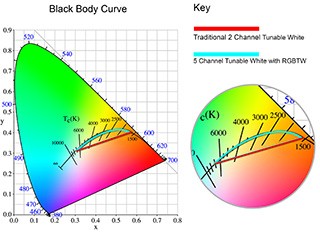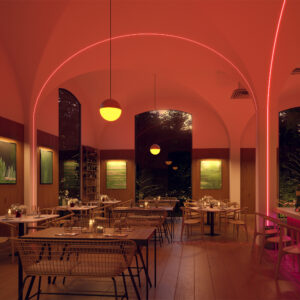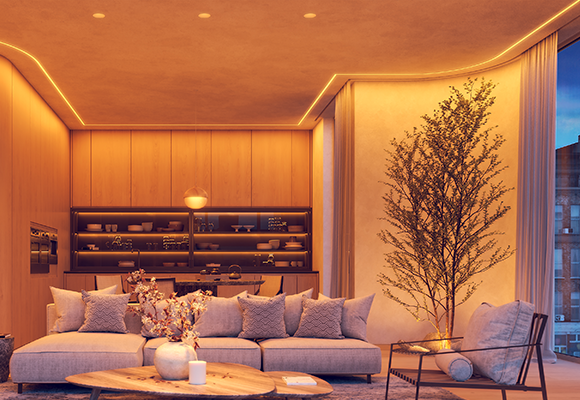Brought to you by PureEdge Lighting
As awareness continues to rise about the impact of the built environment on human health and wellbeing, lighting designers and manufacturers strive to mimic day and night. Our circadian rhythm is a natural biological cycle based on environmental signals, such as the pattern of 24-hour light and dark.
The intake of light at the back of the eye is converted to neural signals to communicate to the brain the perception of night and day. Careful selection of luminaires, lighting controls, and proper design are essential to circadian lighting, which is not about a single luminaire or isolated area; it considers the illuminated environment as a whole.
Industry Standards
Two specifications currently exist for circadian lighting, one promoted by UL and the LRC and the other by the WELL Building Standard. Both institutions use metrics that try to quantify the impact of lighting on melatonin suppression based on lighting in the vertical illumination plane, or the amount of light entering the eye; and that use spectral distribution as their foundation to determine overall impact. But the two metrics differ technically. LRC’s model provides a tool for effective lighting design that is based on a metric LRC developed called Circadian Stimulus (CS). The WELL Building Standard uses a metric it developed called Equivalent Melanopic Lux.
UL has a 6-step guide to aid professionals in achieving the goal of indoor circadian entrainment using the CS method. The LRC, as well as Light and Health Research Center (part of the Icahn School of Medicine at Mount Sinai), have CS calculators available online. The WELL Building and LRC guidance both promote bright light in the mornings and dark nights. Their specifications try to quantify the impact of light on melatonin suppression, based on lighting in the vertical plane and use spectral distribution as their foundation to determine overall impact.
Light Sources for Circadian Lighting
While it is possible to use a static white light source and adjust the lumen output for circadian lighting, it presents some challenges with respect to efficiency and spectral power distribution (SPD). It is easier to achieve circadian lighting with a tunable LED fixture where color (SPD) can be changed from cool white to warm white as the day progresses. Conventional two-channel, linear tunable white allows for color temperatures that mimic natural sunlight; however, it doesn’t follow the black body curve of natural sunlight. Following this parabolic curve requires a wider spectrum of tunable white tones. Lighting that provides three additional LEDs – red, blue, and green – to the two existing tunable white channels (RGBTW) bends the light source’s linear color profile, following the black body curve across the entire spectrum; this allows users to harness the beauty and benefits of natural light.

 Pure Smart™ TruColor™ technology uses five-channels of tunable LEDs (red, blue, green, warm white, and cool white). PureEdge Lighting’s proprietary color mixing produces one of the widest, most accurate spectrums available from 1500K-6500K, offering tunable white with all the vibrancy of colors from sunrise to sunset. It provides a CRI of 94 and DUV of +-.004 in relation to the black body curve at any point on the spectrum of tunable white CCT.
Pure Smart™ TruColor™ technology uses five-channels of tunable LEDs (red, blue, green, warm white, and cool white). PureEdge Lighting’s proprietary color mixing produces one of the widest, most accurate spectrums available from 1500K-6500K, offering tunable white with all the vibrancy of colors from sunrise to sunset. It provides a CRI of 94 and DUV of +-.004 in relation to the black body curve at any point on the spectrum of tunable white CCT.
With WiZ Pro lighting controls, optimizing circadian rhythm is simple in the WiZ app, which provides both a circadian rhythm and custom rhythm feature for various levels of adjustment to preferred levels that still provide effective circadian lighting.
Since its release, tunable white lighting has become more cost-effective can have profound effects on both the physical and mental health of building occupants in many applications including offices, nursing homes, classrooms, retail, restaurant and hospitality industries. Tunable white LED light sources and the control platforms continue to improve while carrying a smaller cost premium over standard LEDs. The latest improvements to CCT can help designers, building owners, and managers provide a positive experience for everyone. The information, standards, tools, and technology are readily available to positively impact the body’s circadian rhythms with artificial light.
Intrigued to learn how PureEdge Lighting’s Pure Smart TruColor or WiZ Pro can meet aesthetic and design goals? Visit www.pureedgelighting.com.

